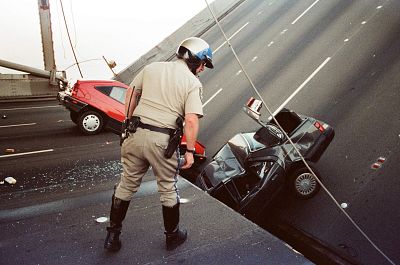The shaking tends to occur along zones of weakness in underground rock formations.
Along with tsunamis and volcanic eruptions, earthquakes are among the most destructive types of natural disasters. They occur when rocky material deep underground shifts suddenly, causing the ground above and nearby to shake violently.
Strong earthquakes devastate entire regions, reshaping surface terrain, toppling buildings and other structures, and injuring and killing large numbers of people.
The worst earthquake on record, which occurred in the Shaanxi province of China in 1556, is believed to have killed 830,000 people. The deadliest quake in the United States was the San Francisco earthquake of 1906, which killed about 3,000 and left half the city homeless.
What causes earthquakes?
Earthquakes, also known as temblors, occur along areas of weakness in the subterranean rocks that make up the Earth's crust. Ordinarily, the rock layers on either side of these zones, or faults, are held in place by friction. But when the friction is overcome by mechanical stresses, the rocks slip and unleash vast amounts of energy that we experience as an earthquake.
The most destructive earthquakes occur at the edges of tectonic plates, which are giant rocky slabs that float on layers of molten rock deep within the Earth. About a dozen tectonic plates make up the world's land surfaces and ocean floors.
"Tectonic plates move continuously, and as they move, their edges are building up stress," John Vidale, a seismologist at the University of Southern California in Los Angeles, said. "Once the stress reaches a critical level, they break as earthquakes."
Where do earthquakes hit?
Earthquake faults are common in subduction zones, where one tectonic plate is slowly moving beneath another. In the U.S., major subduction zones exist in the Cascadia region of the Pacific Northwest and in the Aleutian Islands. Earthquakes are common in these regions.
Quakes are also common in California, of course, but they aren't caused by faults in a tectonic subduction zone. The well-known San Andreas fault is a strike-slip fault, where rock layers slide horizontally past each other instead of up and down, Vidale says.
The Pacific Ocean contains the subduction zones of several tectonic plates. As a result, both quakes and volcanic eruptions are common in the so-called Ring of Fire, a horseshoe-shaped region that coincides roughly with the ocean's perimeter. The region includes parts of New Zealand, Micronesia, Indonesia, the Philippines, Japan, Russia, the Aleutian Islands, the Pacific Coast of North America, Mexico, Central America, Peru and Chile.
What is the Richter scale?
The Richter magnitude scale that was introduced in 1935 by the American scientist Charles Richter has been superseded by more advanced earthquake classifications that use a 1-to-10 scale.
The U.S. Geological Survey reports earthquake strengths under what is known as the Modified Mercalli Intensity Scale. Anything below 4 on the scale is a weak earthquake that causes little or no damage. Intensity 5 quakes are moderate quakes that can break dishes. Intensity 6 and 7 quakes can move furniture and damage buildings. Intensity 8 quakes can collapse chimneys and walls. Intensity 9 quakes can shake large buildings from their foundations. Intensity 10 quakes can destroy entire buildings and bend railroad lines.
Are earthquakes becoming more frequent?
Starting with a 2004 earthquake near Sumatra, which caused a deadly Indian Ocean tsunami, earthquake scientists have noticed an increase in the number of large earthquakes around the world. But that doesn't mean quakes will be more frequent in the future, according to Vidale.
"We tend to argue whether we are in a period of more great earthquakes or not," he says. "It does not really seem like it. It seems like this is just coincidence. But there is the idea that in the last 15 years, there have been a lot of the biggest earthquakes."
Can earthquakes be predicted?
Hazard maps can show where earthquakes are likely to happen and how powerful they are likely to be. But so far, it's impossible to predict quakes with any real precision. Vidale says scientists are pessimistic about the chances of developing an accurate quake-predicting methodology anytime soon — though the USGS is testing an early warning system for the West Coast. Called ShakeAlert, the system is designed to give a few seconds of warning before the shocks from large quakes hit an area.
What's the best way to stay safe during a quake?
The USGS lists safety rules for staying safe, as does the Department of Homeland Security. These include staying indoors, if possible, and seeking shelter under a sturdy desk or table while staying away from windows, fireplaces, heavy furniture and appliances.
People outdoors should stay away from power lines and buildings. Motorists should pull over and stop for the duration of the quake and watch out for fallen rocks and breaks in the road surface when they resume driving.
Construction codes in quake-prone regions help reduce the risk of building collapses and thus are another important tool for keeping people safe and limiting property damage during earthquakes.
"We work on all fronts," Vidale says. "We work on buildings on the scale of decades, with building codes and retrofitting. But at the same time, we are trying to make even better hazard maps, so we know how much shaking people have to be prepared for."
Want more stories about the environment?
- Climate change could trigger a global food crisis, new U.N. report says
- Immense crater may have been found deep under Greenland's ice sheet
- This floating city concept is one way to cope with climate change
SIGN UP FOR THE MACH NEWSLETTER AND FOLLOW NBC NEWS MACH ON TWITTER, FACEBOOK, AND INSTAGRAM.












